Pro Tools' included instruments run the gamut from sample playback (Xpand!2 and Structure Free) to synthesis (Vacuum) to drum machine (Boom). There are also two classic instrument simulations—grand piano and Hammond organ. I'll be taking a look at the latter, the DB-33 Hammond organ plug-in.
The backstory
Real Hammond organ & Leslie cabinet
The Hammond organ is one of the classic electronic (actually electro-mechanical) instruments of the modern era. Dating all the way back to the 1930s, it was originally intended as a replacement for the traditional pipe organ, but found its own voice in gospel, rock, and R&B music, from the '50s and '60s up through the present day. The original utilized mechanical tonewheels to create the sine waves which form the basics of the additive synthesis tones that all organs use to build up a rich sound. Up to nine tonewheel-generated harmonics can be combined for each note played—a total of 91, including an extra to provide an optional percussive “plunk” at the start of each new note. This was all run through a tube-based amp circuit, and, in the most common configuration, amplified by a Leslie cabinet with spinning speakers, to add a unique, rich three-dimensional ambience to the sound. Hammond B3 (and C3) models, through Leslie speakers, provided classic organ tones on hundreds of records over the last 50–60 years. The original mechanical Hammond was taken out of production in the '70s, but it was replaced by electronic simulations (from Hammond and a host of other companies), and now, in the present day, by plug-in simulations as well—that's where the DB-33 comes in.
The DB-33
The DB-33 plug-in offers the same controls and options as the real thing.
The DB-33 is Pro Tools' take on this classic instrument. It's a modeled simulation of the original, which offers not only the sound, but also the original controls and options that you'd have if you were using the real thing. This provides a more realistic simulation, but also means that you need to be familiar with the layout and controls of the original mechanical instrument to get the most out of the plug-in. The DB-33 features not only a complete collection of the (fully-adjustable) knobs and sliders found on the original, but also a simulation of the separate Leslie speaker cabinet, also fully tweakable, down to overdrive characteristics and virtual mic positions.
It's assumed that the player is familiar with the original, so I'll go through the various controls provided, both from the standpoint of basic functionality, and the effectiveness of DB-33's take on each aspect of the classic Hammond/Leslie sound.
The organ itself
On the bottom of the plug-in window are two buttons and an alphanumeric readout. The buttons switch between the interfaces for the organ and Leslie cabinet, and the readout shows the value of the control currently being adjusted.
The Organ & Leslie panes.
On the Organ pane, the main feature is the row of 9 sliders—on a Hammond, these are called drawbars—which dial up the (up to) 9 sine wave Harmonics for each note. They work opposite to a mixer's faders—at the top (0), that tone is silent; pulling each one down increases the level of that harmonic (max level: 8). The combination of these sets the tone, and the factory patches nicely list these settings in traditional Hammond fashion—for example, 888000004 would indicate the lowest three drawbars at maximum (888), and the others off (00000), except for the highest harmonic, at half volume (4).
Three drawbars at maximum (888), and the others off (00000), except for the highest harmonic, at half volume (4).
The white drawbars are the octaves, with the '8' being the primary pitch (the labels—16, 8, 4, etc.—are in feet, after the lengths of the pipes in the organs the Hammond was originally intended to mimic). Popular settings (called “registrations”) range from 888000000 (blues or jazz) to 888888888 (rock), including registrations that emphasize the lower and higher drawbars (some Gospel).
Hammond players love to mess with the drawbars in performance, so to accommodate this, you can right-click each drawbar to assign them to an external hardware MIDI controller's faders (the pre-assigned MIDI CCs can be overwritten), including the option to invert the fader's behavior to match the action of real drawbars (max level at the bottom).
To the right is the Percussion section, where you can switch on a percussive “clunk” at the beginning of each new note, for greater articulation.
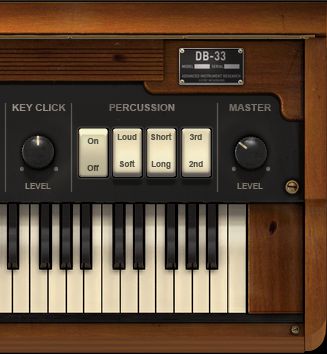
The DB-33 Percussion controls & Key Click.
As on the original, you can choose a louder or softer percussion tone, and a slightly shorter or longer time. The Percussion tone is pitched, selectable as either 2nd or 3rd Harmonic. On the original, the Percussion effect is monophonic—there is only one Percussion tone generator, and it will only sound on the first note played. After that, if any notes or chords are held, no more Percussion tones will sound until all notes are released, and then, again, you'll get the tone only on the first new note played, etc. Not all Hammond simulations recreate this particular quirk, which is very important to any performer who utilizes the Percussion effect, so it's good that it's been implemented properly here.
The Key Click knob lets you add in a mechanical click at the beginning of each note. This was actually a flaw in real Hammonds—an artifact of dirty contact switches—but players liked the extra clarity it gave to the attacks of the notes, so no Hammond simulation worth its salt would be without it now! In this particular simulation, I feel that settings above about halfway (50%) are a bit too pronounced, but that will also depend on the current drawbar settings.
To the left is the Scanner Vibrato. This mimics the on-board vibrato-chorus effect that came with the most popular models (B3/C3). The Leslie speaker cabinet that's always paired with the Hammond was, in fact, a third-party product (from its inventor, Donald Leslie), and Laurens Hammond actually disliked it, preferring Hammond's own internal Vibrato circuit, simulated here.
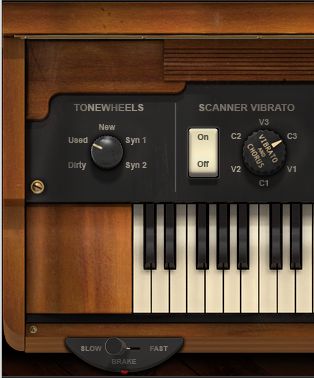
The DB-33 Scanner Vibrato controls.
This is a more subtle (some would say cruder) attempt at providing some animation for the static organ tones. VI, V2, and V3 are Vibrato settings, varying in intensity and shape, and C1, C2, and C3 combine this with the dry sound, for a more subtle chorus effect. It's clearly no substitute for the rich throb of a Leslie speaker cabinet, but many players like to add it in on top of the Leslie, for even more animation, especially when using the faster Leslie speed. C3 is usually the preferred setting for this.
Finally, on the far left, is a knob that lets you choose different simulations of the Tonewheel circuitry that creates the organ notes themselves. New, Used, and Dirty let you choose between simulations of circuits as they would sound fresh out of the box, or the circuitry more commonly encountered on older Hammonds, where the aging components add a little extra grit to the tone. To my ears, the default setting—Used—is the best choice overall for a nice vintage quality, with Dirty being suitable for some edgier rock organ sounds.
The last two options, Syn 1 and Syn 2, simulate not the mechanical tone-generating Tonewheels of the Hammond, but the electronic tone generating circuits of other classic vintage organs (poor man's Hammonds) like Farfisa and Vox Continental (the Animals, the Doors, etc.) With the right registrations (see the appropriate presets), no Leslie, and a little optional Vibrato-Chorus, these can provide a decent simulation of those types of organ tones.
The Leslie cabinet
Switching to the cabinet panel, you find controls to tweak the Leslie speaker simulation.
The DB-33 Leslie controls.
The Input section lets you use the Leslie on either organ or an external sound source (if you insert the plug-in as an effect). Distortion is an important component of the classic Hammond-Leslie sound. The Tube Preamp lets you dial up the amount (Drive) and quality (Character, High Cut) of the simulated tube overload. Character emphasizes higher or lower-frequency distortion, and High Cut mellows out the overall edge. Drive, as expected, determines the degree of distortion. With this plug-in, I feel you have to be a bit careful with the overdrive controls—too much can be a bit harsh and spitty, and you start to lose the characteristic “grind” of the real thing. Drive somewhere between 10 o'clock and noon (for light edge) and 2 o'clock (harder crunch) works well, if you carefully match the amount of distortion with the most appropriate Character and High Cut settings, to keep it from becoming too nasty. I felt I had to work a little harder than with some simulations to get the overdrive just as I wanted it for different sounds, but when I did (and saved the patches), it worked really well, providing that all-important grit that, for many people, is the defining characteristic of the Hammond sound!
The Mics controls let you balance the level of the spinning high-frequency horn and low-frequency drum (another subtle kind of tone control), and you can set the angle of simulated stereo mics (between 90° and 180°). This affects the spread of the back and forth Leslie effect (a combination of stereo tremolo, vibrato, and phasing)—on this simulation, I tend to like it somewhere between 110° and 120° (the default), but higher settings (180°) tend to accentuate the tremolo component of the sound a little more, a characteristic that some players prefer.
Finally the Speed controls determine the rotational speeds of the high-frequency horn and low-frequency drum, (which, incidentally, spin in different directions). Leslie cabinets offer two overall speed options, controlled by a switch (usually mounted on the front left of the organ, just below the lower keyboard manual).
The DB-33 Leslie speed switch, front & back.
The control labelled Acc/Dec (Acceleration/Deceleration) sets the time it takes for the speed to change when that switch is thrown—the gradual ramp-up and ramp-down of the mechanical spinning speakers is a major performance technique (used kind of like the way singers use vibrato in performance). If you're going for the most realistic response, I'd leave these set at their defaults, and use the switch (in either panel) to switch between Slow & Fast settings. Brake is an alternative to the Slow option, which here, as on the real thing, disables the motors, an option utilized sometimes by some players (Booker T Jones). A right-click on this control lets you set it to be controlled externally in performance.
The DB-33 Leslie speed switch CC setting.
The default MIDI controller is Modwheel, but I prefer Sustain pedal, CC#64 (which otherwise has no function on an organ): Sustain down = fast speed, Sustain up = slow speed. With a real Hammond/Leslie, this switch is usually mounted exactly where you see it on the Organ control panel, and operated with the knee—Sustain pedal control is the closest to this mode of operation.
While I'm mentioning external control, the Organ Input knob is preset to respond to MIDI CC#11, which is intended to be supplied by a MIDI continuous expression pedal, standing in for the “Swell” pedal, which provides volume control on the real thing. In fact, most all of the other functions can be controlled via MIDI, as well, for players who want to be able to tweak the parameters in performance as they would if they were playing the real deal.
Wrap-up
So that's the DB-33. It does a commendable job of simulating the classic Hammond/Leslie combination, and is true to the quirks of the original, so it should have no trouble providing convincing sound for any MIDI organ tracks you might throw at it. And, most importantly—it's just fun to play!


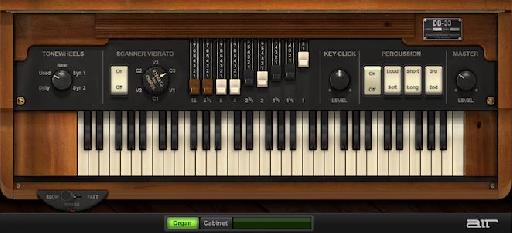

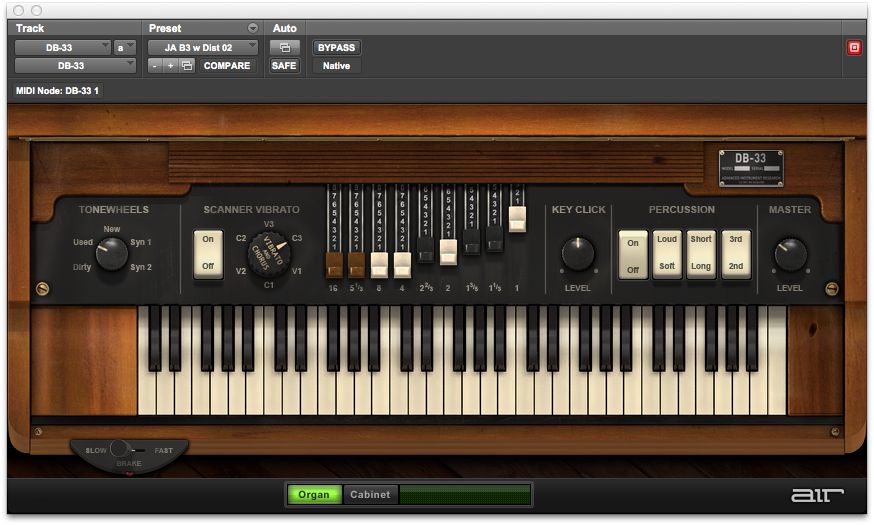
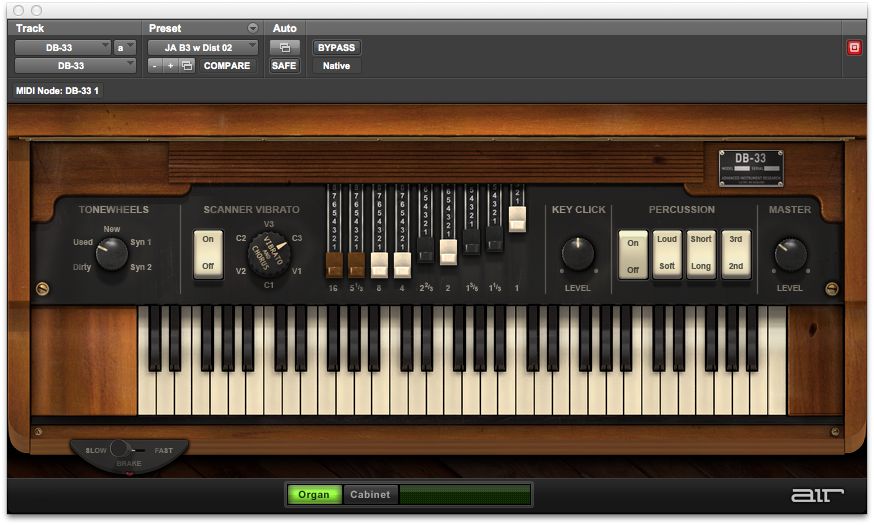
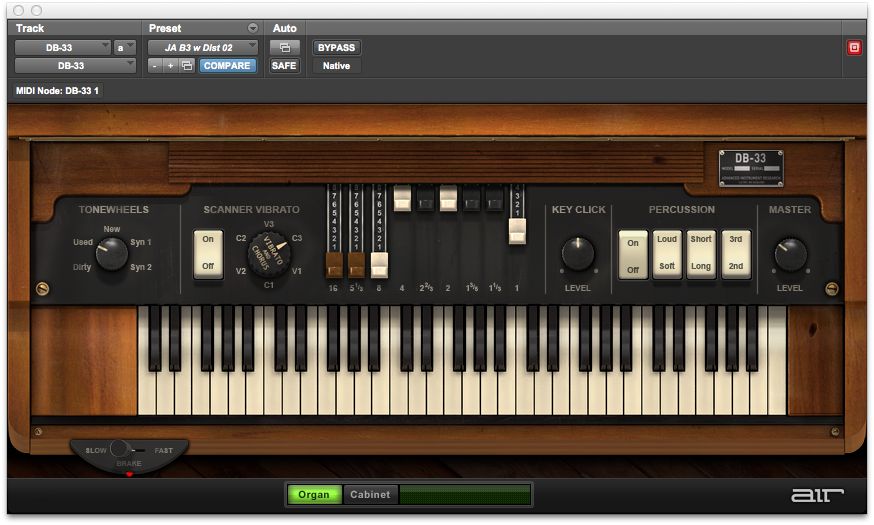

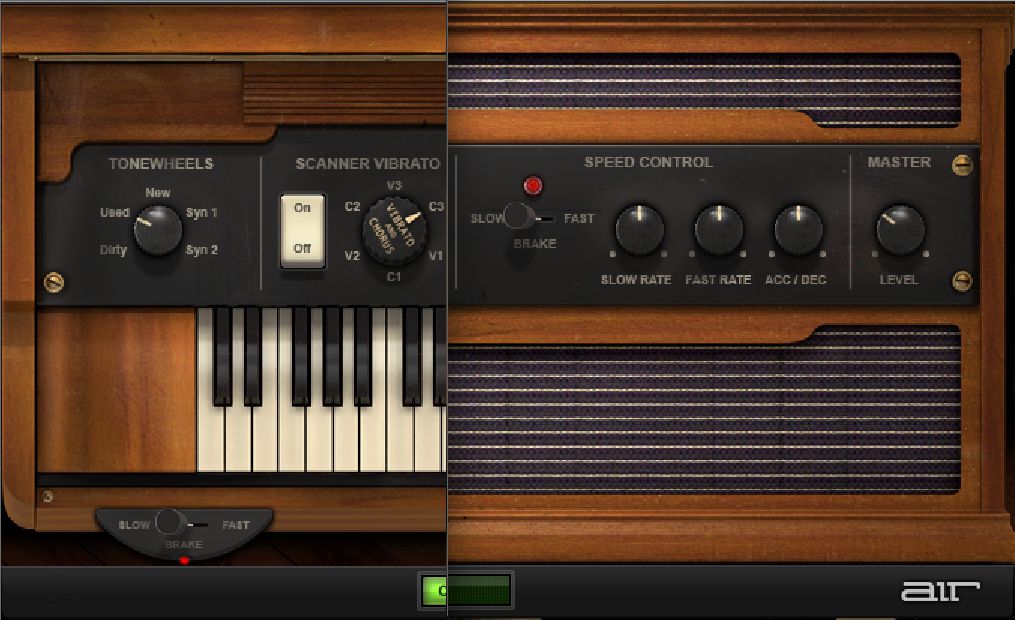
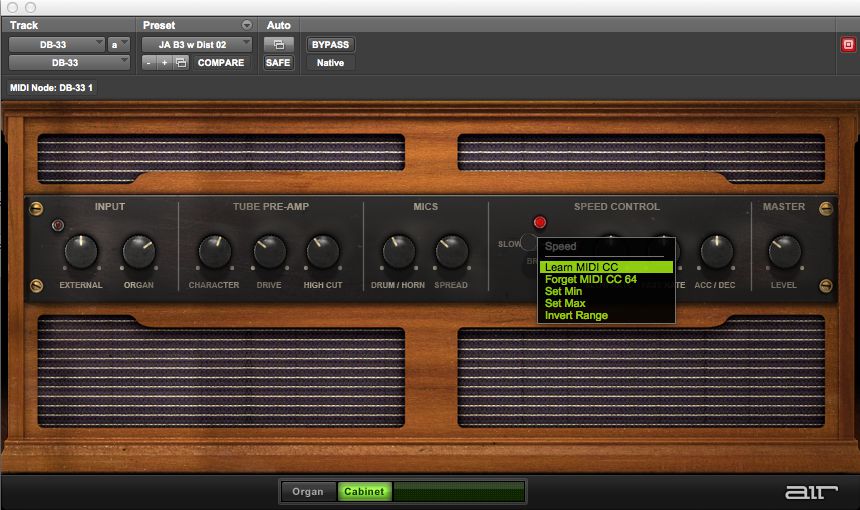
 © 2024 Ask.Audio
A NonLinear Educating Company
© 2024 Ask.Audio
A NonLinear Educating Company
Discussion
Want to join the discussion?
Create an account or login to get started!